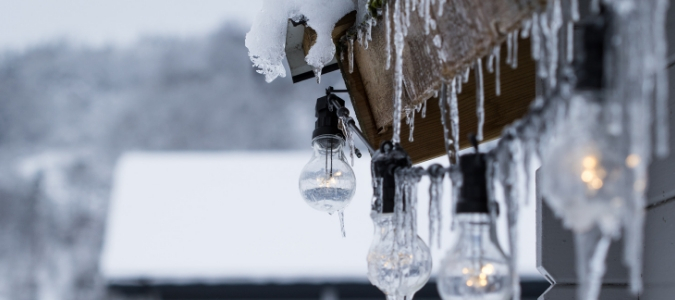
If you take a look at the thermostat that controls your home’s heating and cooling systems, you might notice a switch or button labeled “EM heat.” If you see this, your home probably has a heat pump. The first part of the phrase “EM heat” stands for emergency. The emergency heat setting on your thermostat controls your heating system’s auxiliary heat source, which can be tapped into when outside temperatures drop below a certain threshold—usually anything colder than 35 to 40 degrees Fahrenheit. Now that you understand the answer to the original question—What is EM heat on a thermostat?—let’s learn more about this setting and why it comes on.
When functioning properly, the heating system’s heat pump pushes warm air from inside your home to the outside during hot weather and moves heat to the inside during cold weather. When outdoor temperatures drop into the thirties, however, it can become too cold for the heat pump to pull enough warmth into the home to achieve the desired heating level. In this situation, the system’s emergency heat source can kick in. This auxiliary source might be connected to the home’s gas furnace, or it might be in the form of electrical radiant heat strips. Either way, low outdoor temperatures make it tougher for the heat pump to warm up your home on its own, so your EM heat helps pick up the slack.
In a system that is functioning normally, EM heat should kick in automatically during the phases of the heat pump’s cycle when it turns off temporarily in order to defrost the unit outside. It is normal in colder weather for the coils in the outdoor unit to gather moisture from the air, which turns into frost on the coils. In this phase, the system’s EM heat switches on to warm the home for a short period of time until the heat pump kicks back in.
The most important thing to know about the EM heat setting is that it is intended to be on only under extremely limited conditions. Running your system using EM heat is significantly more expensive that the regular setting. For this reason, while EM heat can also be activated manually in some systems, a homeowner should not turn on this setting unless the heat pump has failed and a heating and cooling professional has been contacted to fix the problem.
There are many questions homeowners have about utilizing EM heat, as it is not a feature that is used frequently. In this post, we’ll review some of the most common questions and problems that homeowners have regarding emergency heat, including when they should be using it, what to do if it is not working and what to do if it is running constantly.
One of the most common questions about this setting is about the difference between aux heat and emergency heat.

Aux Heat Vs. Emergency Heat: Are They The Same Thing?
Many people wonder about aux heat vs. emergency heat: Are they the same thing, or are there differences between the two? The short answer is that auxiliary heat and emergency heat refer to the same thing, and are somewhat interchangeable.
Homes with heat pumps are equipped with a two-part system: The heat pump, which is the outdoor element, and the auxiliary heating source, which is the indoor element. This auxiliary source might be either a gas furnace or a series of electrical radiant heat strips. The emergency heat, or EM heat, setting on your thermostat shows you when this auxiliary system is in use, and it can also be activated manually if your heat pump malfunctions or stops working altogether.
In short, when your home’s auxiliary heat source is in use, your thermostat will indicate that EM heat is on. Another option you have is to switch on the EM heat yourself to heat your home temporarily if the heat pump isn’t working. In either of these scenarios, you need to know under what conditions EM heat should be activated.

When To Use Emergency Heat
Many homeowners aren’t sure exactly when to use emergency heat, while others believe EM heat is a setting to be used on extra-cold days in order to keep their homes warmer. The truth, however, is that EM heat should be used only when the heat pump isn’t working. If that happens, you should also call a licensed heating specialist to service the heating system as soon as possible. In short, the emergency heat setting is designed to be used only temporarily, to keep the house warm while the heat pump is off—whether it is actually malfunctioning and in need of repair, or it’s simply in the defrost phase of its cycle and will kick back on again soon.
When a homeowner manually activates the EM heat setting on their thermostat, this causes the system to bypass the heat pump, forcing the system’s auxiliary heat source, such as the furnace or the radiant heat strips, to kick in and supply all the heating to the home. Since EM heat uses far more energy than a properly functioning heat pump-based system, long-term use of the EM heat setting would be quite expensive and should be avoided. If you have let your auxiliary heat run for most of the month, this could likely be why your electric bill is so high. If you do find yourself in this situation, you’ll want to know what your best next steps are.

EM Heat Not Working: What To Do Next
EM heat not working? If it feels like cold air is blowing out of your vents when the heat is on, it’s easy to automatically assume your EM heat is not working, but that is actually not always the case. If it’s extremely cold outside, such as in the twenties or below, it’s entirely possible that your heating system’s heat pump and emergency heat source are both working normally, but simply can’t heat the home properly due to the excessively low temperatures outdoors.
If your EM heat is truly not working, or it isn’t working efficiently, there are several reasons why this might be, including the possibility that your heating unit is low on refrigerant. Another possibility is that a tree branch, weighed down by ice, snapped off and fell onto your outdoor unit, damaging it. A third possibility is that the coils in your outdoor unit froze. If the emergency heat source in your home isn’t working properly and is unable to warm up your outdoor unit so it can work as it’s intended, you’ll want to have the system inspected by a licensed heating specialist, who can provide an accurate diagnosis of the problem and fix or replace any malfunctioning elements.

Heat Pump Runs Constantly In Cold Weather: Is This Normal?
If you are worried that your home’s heat pump runs constantly in cold weather, you aren’t alone. The good news is that it is normal for a heat pump to run constantly in winter—at least, when temperatures are consistently around 30 degrees or below. Your heating system’s EM heat or aux heat indicator may also turn on periodically, indicating that the auxiliary heat source in your home is also doing its job of kicking on temporarily when the heat pump is in defrost mode.
If your heat pump runs constantly in the summer, however, when it’s in its cooling mode, that could signal a problem. It’s always a good idea to make sure the heating system’s air filter is clean, the thermostat is set properly, the condensate pump is plugged in and the outdoor unit is running.
If you have done all of these checks and something is still off, then it could be that the refrigerant levels in your heat pump unit are too low, which could indicate a leak somewhere in the system. It’s also possible that the solenoid valve is malfunctioning or has failed, which would cause the system to get stuck in AC mode. A third possibility is that the unit is too small for the size of your home, so it can’t work efficiently to cool the entire space. If the problem originates in the outdoor unit, it’s time to call a specialist to determine why the system stopped functioning correctly.
Most problems with your home’s emergency heat setting or heat pump are best handled by a heating specialist. A licensed HVAC professional is the best person to consult for any heating question or issue, since these technicians have the experience and expertise necessary to provide an accurate diagnosis and determine the best way to get your home’s heating system back up and running.
ABC Can Handle Your Heating Issues
When temperatures drop drastically, having a malfunctioning heat pump can make your home uncomfortable. On the other hand, if the emergency heat is constantly running, you could run into another problem if you end up with an abnormally high electric bill. No matter what is going on with your heating system, you can rely on the licensed professionals at ABC Home & Commercial Services to get your space warm and cozy again. We even offer 24/7 emergency services for those problems that just can’t wait, so that you aren’t left out in the cold for long.
